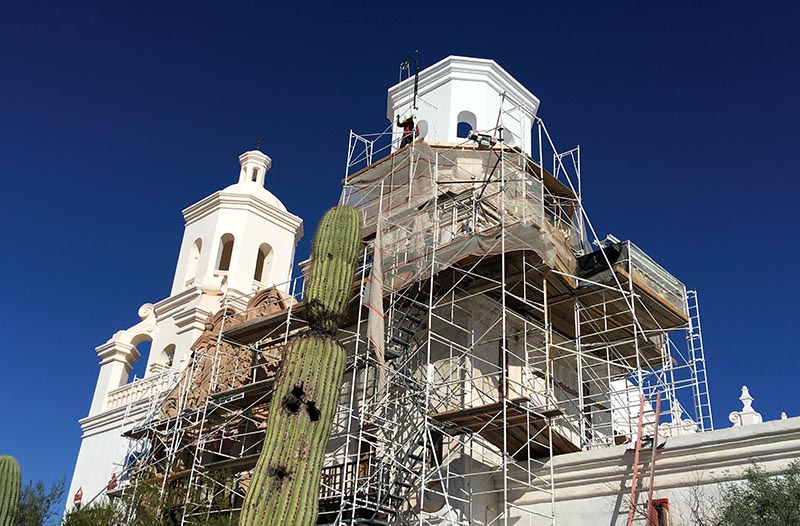
View of the scaffolding setup on the East Tower. The uppermost portion has been removed to reveal the completead top.
Patranato San Xavier
In response to these challenges Partners for Sacred Places founded the National Fund for Sacred Places in collaboration with the National Trust for Historic Preservation. The only program of its kind, the National Fund provides matching grants of $50-250,000 to congregations undertaking significant capital projects for purpose-built historic houses of worship. To ensure the success of each capital fundraising project, the National Fund provides congregations with wrap-around services, including a $5,000 planning grant, capacity-building training, and tailored technical assistance.
Now in its seventh year, the National Fund has awarded and pledged $18 million to 97 community-serving congregations representing 24 faith traditions in 36 states, the District of Columbia, and Puerto Rico. We are excited to highlight two participants who have completed their capital projects in 2022: San Xavier del Bac Mission in Tucson, Arizona and Lovely Lane United Methodist Church in Baltimore, Maryland. From the Sonoran Desert to the bustling streets of Baltimore, the two seemingly polar-opposite projects offer a glimpse into how the National Fund works with congregations across the United States to support the continued care and use of their historic properties as centers for community life.
San Xavier del Bac Mission,
Tuscan, Arizona
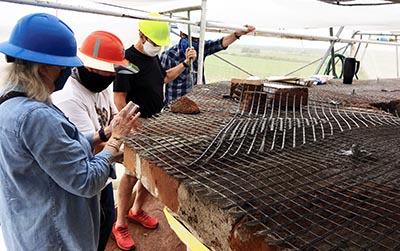
Patronato’s Conservation Committee examine the installation of the basalt rope bond beam and webbing used to stabilize the top of the tower.
Patranato San Xavier
In 1692, Father Eusbio Kino founded the San Xavier del Bac as a Catholic mission on the lands of the Toronto O’odham people. Three centuries later, the Mission continues to serve its surrounding community in the village of Wa:k as both a center of worship and community life. Today attendance for parish services averages 400. In addition, the Mission supports a tuition-free K-8 school, provides a variety of counseling services, and hosts numerous annual festivals on its campus.
Architecturally, the church’s iconic twin-tower profile melds both the Spanish Baroque influence of master mason Ignacio Gaono and the local construction techniques utilizing the adobe and volcanic stone materials of the region. Constructed between 1783 and 1797, the current church is the oldest intact non-native structure in Arizona. In recognition of the numerous heritage values of the site, the non-profit Patronato San Xavier was founded to guide its continued preservation.
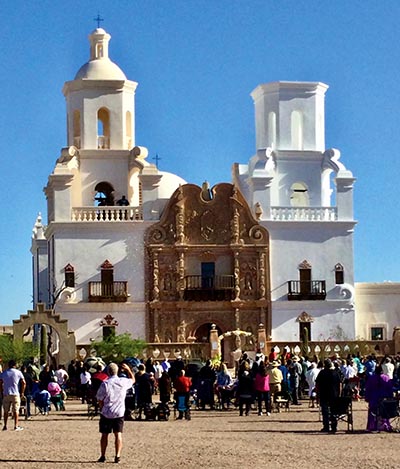
The first Easter service following the restoration work at San Xavier.
Martin DeSoto
When Patronato came to the National Fund in 2018, the focus of preservation efforts was clear – to stabilize and repair the East Tower. Due to a sudden stop in the church’s construction in 1797, the East Tower was never finished. Both the dome and lantern featured on the West Tower were never added on the East Tower. Perhaps most significantly, the upper levels were left unplastered until the 20th century, leaving the adobe walls exposed to the harsh weathering elements of the Sonoran Desert. With $250,000 in support from the National Fund, along with $500,000 in matching funds raised by Patronato and the parish, Patronato was able to take measures to conserve the tower and ensure the safety of visitors to the site.
To begin, conservators worked on site to remove delaminated layers of Portland cement applied in the mid-twentieth century – a material that is incompatible with the underlying adobe. Once the adobe walls were repaired, the tower was refinished with a lime-based plaster infused with cactus – a local craft tradition. To add stability, a basalt rope bond beam and webbing was installed. In alignment with the site’s conservation principles, extra caution was taken throughout the project to preserve the unique profiles and irregularities created by the original craftsmen. Through the conservation team’s deep contextual understanding of the site and the ingenuity of local materials, the East Tower was conserved in a way that brought unity to the greater ensemble while respecting the existing character.
For the first time in six years, the congregation can return to a church facade free of scaffolding and safety barriers. In reflecting on the campaign process, Patronato shared that the grant provided through the National Fund was able to reignite support from local stakeholders and cultivate energetic momentum for future conservation efforts. Miles Green, Executive Director of Patronato, said of the project, “With the iconic East Tower at the Mission now stabilized and repaired, we have new impetus moving forward with other core projects on the Mission site.”
Lovely Lane United Methodist Church, Baltimore, Maryland
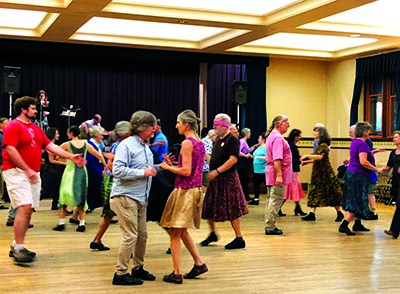
Baltimore Folk Music Society dancers enjoying Lovely Lane UMC’s Fellowship Hall.
Rev. Deb Scott.
Amidst a streetscape of rowhomes, the massive stone tower of Lovely Lane UMC undoubtedly catches the eyes of everyone walking by. Designed by Stanford White, Lovely Lane is one of the only Romanesque churches completed by the renowned architecture firm of McKim, Mead, and White. Today, Lovely Lane boasts a history as monumental as its tower, and has proven to be a cultural anchor in its home of Baltimore and beyond.
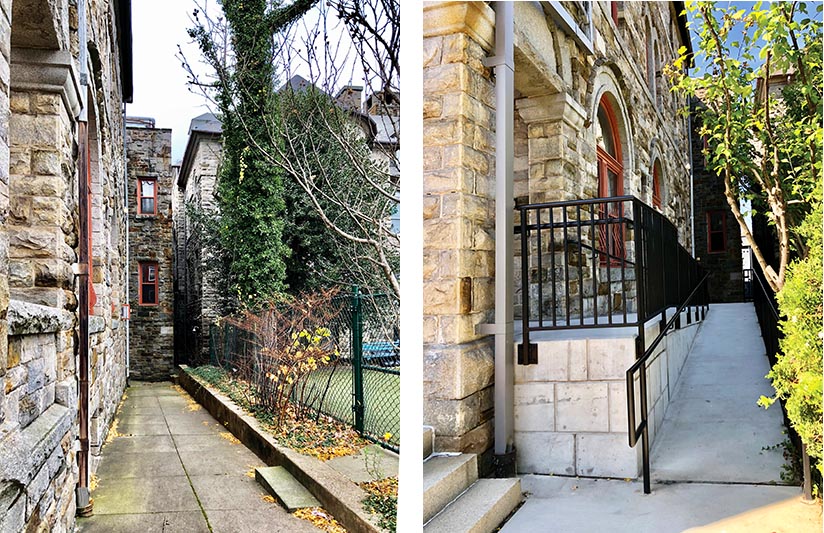
Before and after view of the new access ramp to the main entrance, looking towards St. Paul Street.
Rev. Deb Scott.
The history of Lovely Lane dates back to both the founding of the nation and the formation of the Methodist denomination in America. The congregation was first established in 1772 as a part of the reform movement of the Anglican Church of England. However, after the start of the American Revolution in 1776, the congregation split from the Anglican Church of England to help form a denomination, a few years before Methodists broke away from the Anglican church in Great Britain. The modern United Methodist Church, thus, has its roots in one of the church’s earlier buildings. The stately Romanesque Revival church seen today was constructed in 1884, as a centennial monument to the founding of the denomination.
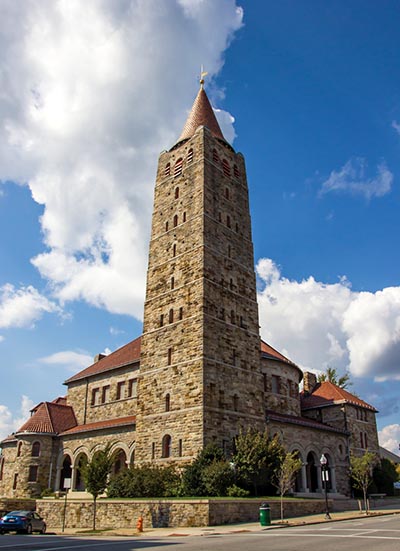
View of the Exterior of Lovely Lane UMC from the corner of St Paul and E 22nd Street.
Lovely Lane Archives.
Lovely Lane has continued to embody this shared history with its visitors, dedicating space on its campus to the United Methodist Historical Museum. In addition, Lovely Lane has opened its space to numerous creative partnerships, including the Baltimore Lab School and the Baltimore Folk Music Society. In order to continue to best serve its partners as a community facility and enhance sustainable operations, the church wanted to update the building amenities and complete exterior repairs. In 2019, Lovely Lane was awarded $250,000 through the National Fund, matched by an additional $500,000 raised by the congregation to tackle these building needs. The church has successfully added an accessible entrance, additional restrooms and climate control units for visitor comfort. In addition, the work included stabilization of several Tiffany stained glass windows in the chapel.
Looking forward, the church hopes to continue to welcome visitors as both a hub of civic life in Baltimore and as a destination of architectural and historical interest. The completed work has enhanced the church’s capacity for hospitality and opened the door to new opportunities for community engagement. Soon, the Baltimore Folk Music Society will have participants dancing across the Fellowship Hall again – now fully air-conditioned!
The 2022 COHORT of the
National Fund for Sacred Places
In October, Partners and the National Trust for Historic Preservation welcomed sixteen new
congregations into the 2022 cohort of the National Fund for Historic Places. Collectively, these
congregations are slated to receive over $2.1 million in grant funding. The congregations are:
- Arch Street Meeting House (Philadelphia, PA)
- Boynton Chapel United Methodist Church (Houston, TX)
- Calvary Baptist Church (Minneapolis, MN)
- Christ Church Detroit (Detroit, MI)
- Church of St. Francis of Assisi (San Juan, PR)
- Crossnore Presbyterian Church (Crossnore, NC)
- Dover Friends Meetinghouse (Dover, NH)
- East Mount Zion Baptist Church (Cleveland, OH)
- Ebenezer Baptist Church (Atlanta, GA)
- First Presbyterian Church of Wilkes-Barre (Wilkes-Barre, PA)
- Greenstone United Methodist Church (Chicago, IL)
- Immanuel Presbyterian Church (Albuquerque, NM)
- Saint Mark’s Church (Philadelphia, PA)
- St. Rita Catholic Church (Indianapolis, IN)
- Union United Methodist Church (Boston, MA)
- Wicker Park Lutheran Church (Chicago, IL)
